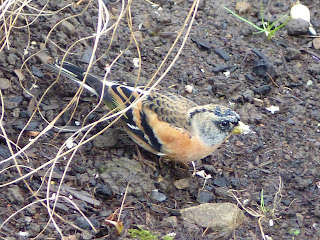It's been a good year at Linacre, with 2 new species added to the list of birds seen (Shoveler and Shag). The first species, was spotted on 4th November when 2 birds were reported on the Sheffield Bird Study Group website. The second species was found by me on 21st November, when 8 birds were recorded. They were reported on most days, up until the 3rd December, after which 5 and then 3 were seen until the end of the year. The record of 8 birds is the second highest count ever for Derbyshire, following 11 at Ogston Reservoir in 1993.
Shags (6 of the 8 birds)
Along with these two new species the following waterbirds were also recorded during the year: Canada Goose, seen in 5 months, with a high count of 9 birds in October; Greylag Goose, 3 records, 1 of 2 birds ( a pair?) in April, 1 flying over the ringing site in May, and 3 flying together over the middle reservoir in December, the first winter record; Pink-footed Goose, 2 records this year of 75 birds in September (1 skein), and 2 skeins totaling 160 birds on 28th December, both sightings referred to birds flying over the site; Mandarin Duck, recorded in ever month, with a high count of 77 birds in November and successful nesting recorded in two "owl boxes", Mallard, recorded in every month, with a high count of 135 in November and successful breeding proven; Tufted Duck, recorded in every month, with a high count of 83 in November, and successful breeding proven for the fourth time in the last 6 years; Goosander, recorded in five months, with a high of 8 in December; Little Grebe, a poor year for this species, with singletons recorded in five months, and no evidence of breeding for the second year in a row; Great-crested Grebe, birds were recorded in nine months, and 2 pairs were present during the breeding season, though neither was successful this year, Cormorant, recorded in nine months, with a high count of 5 birds in November; Grey Heron, recorded in nine months, with a high count of 3 in January; Moorhen, recorded in every month, with a high count of 15 in November, and successful breeding proven again, Coot, recorded in every month, with a high count of 22 in July, and successful breeding proven again, Black-headed Gull, recorded in 6 months, with a high count of 130 in January, and Kingfisher, recorded in 6 months, with 2 birds seen regularly in December, perhaps due to the increased number of visits to record the Shags. The two least common waterbirds Wigeon and Teal remained uncommon again in 2015. Wigeon was recorded on just 2 occasions this year, with 7 in October and 1 juvenile in November. The juvenile bird was thought possibly to be a hybrid. Teal had its best year yet, with 3 records, including 1 in March, 2 juvenile/females in October and 3 males in November.
Waterbirds not recorded this year were: Mute Swan (last seen in December 2013), Whooper Swan (last seen in January 2014), Goldeneye (last seen in November 2014), Gadwall (last seen in October 2013), Red-crested Pochard (last recorded in March 2006), Pochard (last recorded in September 2013), Red-breasted Merganser (last recorded in February 2009) and Common Scoter (last recorded in October 2007).
The BTO's WeBS count was carried out every month in 2015,sometimes by me, sometimes with my nephew, but mostly by several members of Chesterfield RSPB Group, so many thanks to everyone who took part.
Wader records were low in 2015, with just 1 record of Woodcock in November. There were no records of Lapwing, Common Sandpiper,Oystercatcher, Curlew or Little Ringed Plover. Other birds not recorded in 2015 were: Green Woodpecker, Willow Tit, Lesser-spotted Woodpecker, Pied Flycatcher, Spotted Flycatcher, Garden Warbler, Linnet and Crossbill.
The final record of note for 2015 was my first ever December record of Chiffchaff. One bird was found feeding with a flock of Long-tailed Tits.



















































